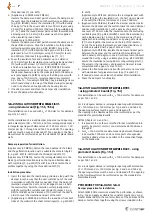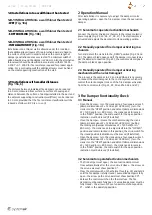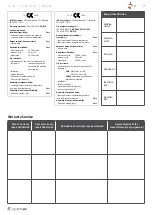
PKIR, PKIS
| PP-28_201612 | 43 / 48
5 Warranty Conditions:
For warranty conditions ask please our Systemair colleagues
in your country.
Before you can install the fire damper, it‘s functionality must
be tested as per chapter 3 (Fire Damper Functionality Check)
DO NOT INSTALL NON-FUNCTIONING FIRE DAMPERS!
Changes of fire damper functionality, caused by transport or
installation, aren‘t reclaimable after installation (deformations,
damages, mechanical damage of the sealing material,
foreign objects which can constrain the blade movement, wrong
handling of the activating mechanism etc.)
Before you can connect the fire damper into the ductwork,
the fire damper functionality must be checked again (according
to chapter 3, in Fire Damper Functionality Check).
4 Damper Inspection
The activating mechanism keeps the dampers on stand-by
during their entire life cycle in accordance with the Operation
manual issued by the manufacturer. Without the manufacturer’s
consent it is not permitted to alter the dampers in any way nor
perform any changes to their structure.
The operator performs regular checks of the dampers as per
established regulations and standards at least once
in 12 months. The check needs to be performed by an employee
who has been specifically trained for this purpose by the manu-
facturer. The current fire damper condition determined during
the inspection needs to be entered into the operating logbook
along with the date of the inspection, a legible name, surname
and signature of the employee who performed the inspection.
The journal includes a copy of the employee’s authorization.
If any discrepancies are discovered, these need to be entered in
the operating journal along with a proposal for their removal.
The journal can be found on the last but one page of this manual.
Immediately after the damper installation and activation it needs
to be checked with the identical conditions as apply for the
above mentioned 12-month inspections. The table for damper
activation can be found on the last but one page of this manual.
The visual check enables visible damages on the inspected dam-
per parts to be seen. On its external side the damper housing and
the activating mechanism are checked. Due to the need to per-
form a visual check of the damper’s internal parts, it is necessary
to dismount the base plate with the activating mechanism, which
will enable us to access the inside of the damper or open the
inspection lid if the damper is equipped with one. The removable
mechanism always needs to be dismounted from the damper
and returned back into the damper with the damper blade being
closed. We check the damper’s internal casing, thermal fuse,
sealings, foaming substance, the damper blade condition and ac-
curacy of its closure during its leaning against the backstop in the
closed position. There must not be any strange objects or a layer
of impurities from the air distribution systems inside the damper.
NEVER OPEN THE INSPECTION LID WHEN THERE IS AIR FLOWING
IN THE DUCT CONNECTED TO THE FIRE DAMPER!
Recommended course of action and inspection
log as per EN 15 650:
1. Damper identification
2. Date of inspection
3. Check of electric connection of the activating mechanism
(where applicable)
4. Check of the damper for cleanliness and possible need
for cleaning (where needed)
5. Check of the blade and sealing condition, possible correction
and log (where needed)
6. Check of the proper fire damper closure – details can be
found in the previous paragraphs
7. Check of the damper functionality – opening and closing using
the control system, physical examination of the damper’s
behavior, possible correction and log (where needed)
8. Check of the end switches’ functionality at an open and a
closed position, possible correction and log (where needed)
9. Check whether the damper is fulfilling its role as part
of the regulation system (where needed)
10. Check whether the damper remains in its standard operating
position.
The damper is usually part of a system. In that case the whole
system needs to be checked as described in its operation and
maintenance requirements published by the builder of the system.



























